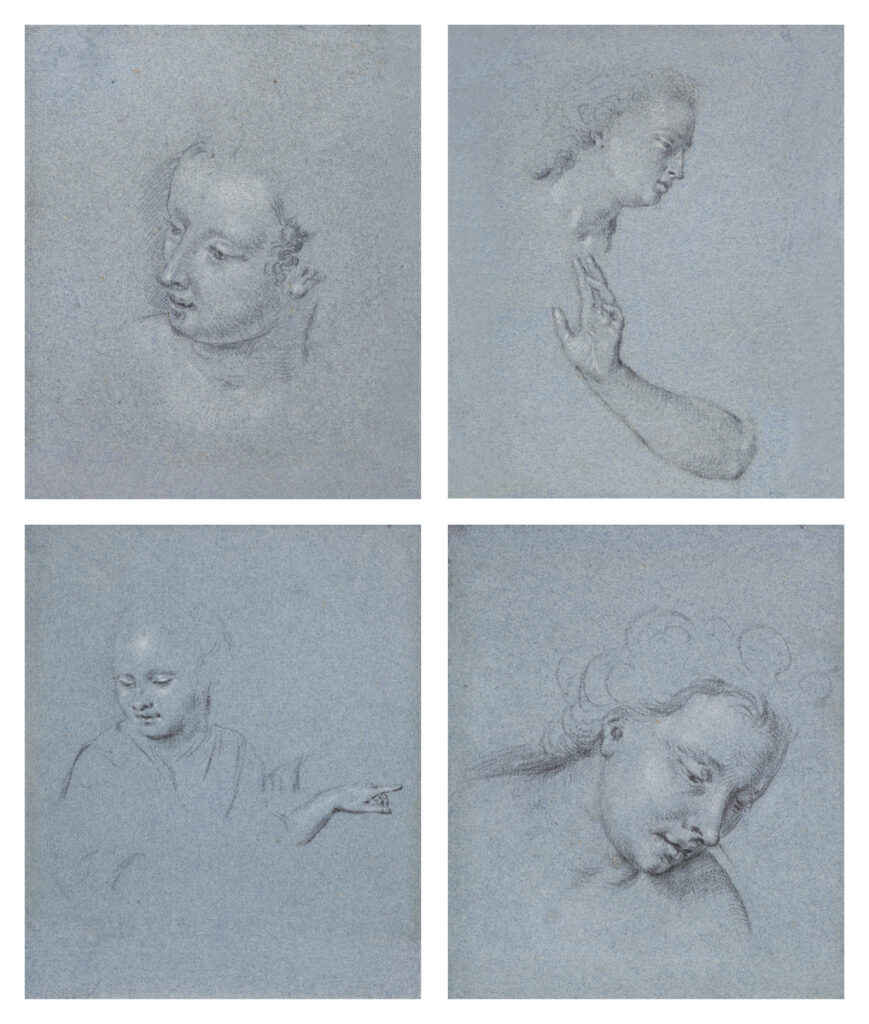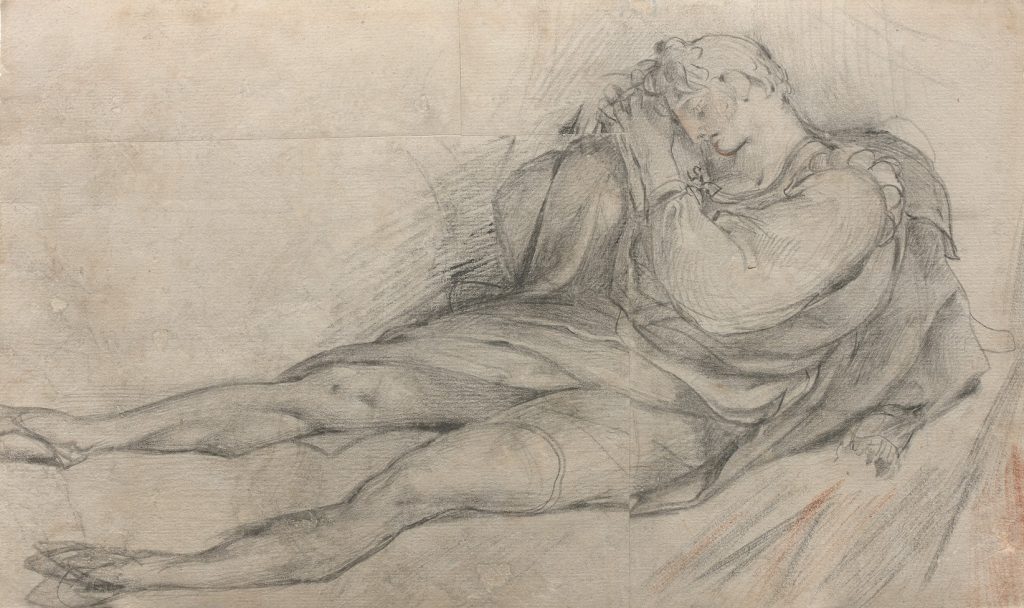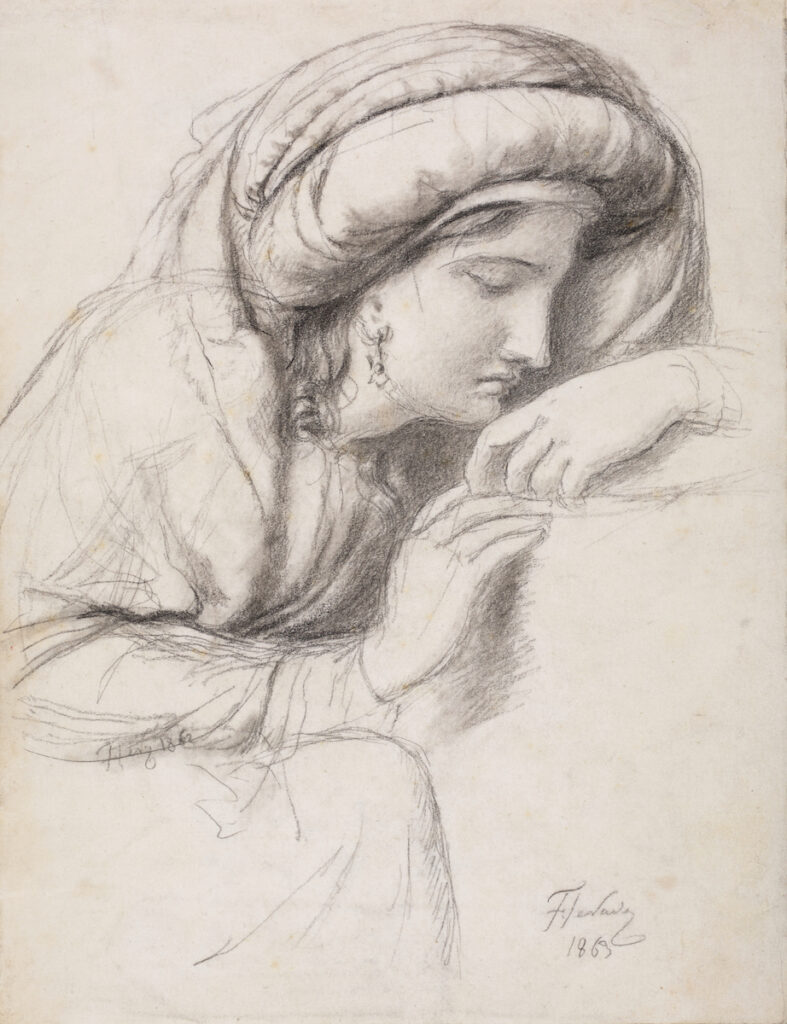
Willem van Mieris (1662-1747)
Head Study of a Young Woman Looking to the Left
Black stone and white chalk on blue paper
148 x 115mm (513/16 x 41/2 in.)
Studies of a Woman's Head Turned to the Right and a Raised Hand
Black stone and white chalk on blue paper
145 x 105mm (511/16 x 41/8 in.)
Study of a Young Girl Pointing her Finger to the Right
Black stone and white chalk on blue paper
140 x 115mm (5½ x 41/2 in.)
Study of the Head of a Woman Looking Down to the Right
Black stone and white chalk on blue paper
132 x 112mm (53/16 x 47/16 in.)
Provenance:
Michel Segoura Gallery, Paris;
Private collection, Paris
Drawing was important to Willem van Mieris. In 1694 he founded an Academy of Drawing in Leiden, which he directed until 1736. Willem van Mieris was a prolific draftsman and his graphic corpus includes mostly two types of drawings: copies the artist made of his own paintings, executed in a highly finished and meticulous manner, and sometimes elaborated with gouache on parchment; and drawings made as preparatory to paintings, most often executed in black and white chalk on blue paper. Our four drawings, characteristic of this second technique, are likely studies for paintings. Willem van Mieris usually kept drawings of the second type in a portfolio for future reference for a painting. Indeed, two of our drawings can be related to known compositions by the artist: the Study of a Woman's Head Looking to the Right is preparatory for the face of the woman painted in The Drunkenness of Silene in the Clermont-Ferrand Museum; and the pose of the Young Girl Pointing her Finger to the Right was later used by the son of Willem van Mieris, Frans von Mieris, in his painting Bacchus and Ariadne.
148 x 115mm (513/16 x 41/2 in.)
Studies of a Woman's Head Turned to the Right and a Raised Hand
Black stone and white chalk on blue paper
145 x 105mm (511/16 x 41/8 in.)
Study of a Young Girl Pointing her Finger to the Right
Black stone and white chalk on blue paper
140 x 115mm (5½ x 41/2 in.)
Study of the Head of a Woman Looking Down to the Right
Black stone and white chalk on blue paper
132 x 112mm (53/16 x 47/16 in.)
Provenance:
Michel Segoura Gallery, Paris;
Private collection, Paris
Drawing was important to Willem van Mieris. In 1694 he founded an Academy of Drawing in Leiden, which he directed until 1736. Willem van Mieris was a prolific draftsman and his graphic corpus includes mostly two types of drawings: copies the artist made of his own paintings, executed in a highly finished and meticulous manner, and sometimes elaborated with gouache on parchment; and drawings made as preparatory to paintings, most often executed in black and white chalk on blue paper. Our four drawings, characteristic of this second technique, are likely studies for paintings. Willem van Mieris usually kept drawings of the second type in a portfolio for future reference for a painting. Indeed, two of our drawings can be related to known compositions by the artist: the Study of a Woman's Head Looking to the Right is preparatory for the face of the woman painted in The Drunkenness of Silene in the Clermont-Ferrand Museum; and the pose of the Young Girl Pointing her Finger to the Right was later used by the son of Willem van Mieris, Frans von Mieris, in his painting Bacchus and Ariadne.

Jan van Huysum (1682-1749)
Bouquet of Flowers on a Pedestal
Black chalk and gray wash, pen and brown ink, white gouache, blue watercolor,
framing lines in pen and brown ink
200 x 150 mm, 7 7/8 x 5 15/16 in.
Jan van Huysum was one of the most outstanding Dutch flower painters of the eighteenth century. He was celebrated during his lifetime for his meticulously rendered flowers and the high level of realism of his paintings. Van Huysum worked directly from nature, an understandably slow process that could involve waiting for a season to return in order to finish certain flowers. The present drawing, executed with a free and lose hand, is characteristic of the drawings executed by van Huysum to prepare his paintings. In these drawings, Van Huysum explored arrangements of color and shape, and the flowers are rarely defined.
framing lines in pen and brown ink
200 x 150 mm, 7 7/8 x 5 15/16 in.
Jan van Huysum was one of the most outstanding Dutch flower painters of the eighteenth century. He was celebrated during his lifetime for his meticulously rendered flowers and the high level of realism of his paintings. Van Huysum worked directly from nature, an understandably slow process that could involve waiting for a season to return in order to finish certain flowers. The present drawing, executed with a free and lose hand, is characteristic of the drawings executed by van Huysum to prepare his paintings. In these drawings, Van Huysum explored arrangements of color and shape, and the flowers are rarely defined.

Georg Friedrich Schmidt (1712 - 1775)
Presumed Portrait of the Sculptor Paul Ambroise Slodtz
Black chalk, red chalk, white chalk, blue pastel
255 x 225 mm
Provenance: Private collection, Switzerland
In parallel with his engraving activity, Schmidt executed portraits drawn in “trois crayons” highlighted with pastel. During his stay in Paris, Schmidt drew portraits of members of the Royal Academy such as Maurice Quentin de la Tour, Nicolas Cochin or Étienne Poitreau. The facial traits of the sitter are similar to those of the sculptor Paul Ambroise Slodtz, professor at the Academy in 1743, the year Schmidt was also a member.
255 x 225 mm
Provenance: Private collection, Switzerland
In parallel with his engraving activity, Schmidt executed portraits drawn in “trois crayons” highlighted with pastel. During his stay in Paris, Schmidt drew portraits of members of the Royal Academy such as Maurice Quentin de la Tour, Nicolas Cochin or Étienne Poitreau. The facial traits of the sitter are similar to those of the sculptor Paul Ambroise Slodtz, professor at the Academy in 1743, the year Schmidt was also a member.

Abraham van Strij I (1753-1826)
Portrait of Jacob van Strij, the artist’s brother
Red chalk, red chalk wash, black chalk, brown wash
167 x 114 mm (6 ½ x 4 ½ in.)
Signed by the artist with his monogram lower right
Provenance: Jacob Hendrik Wiegersma, dit Jaap Wiegersma (L. 1552b) ; E. Maurice Bloch; his sale, Christie’s New York, 9 january 1991, lot 23
Abraham van Strij and his brother, Jacob van Strij, were two of the most important artists active in Dordrecht in the second half of the eighteenth century. Abraham van Strij distinguished himself as an outstanding draftsman. He founded Pictura in 1774, a drawing society, which he was director of throughout his life. In the present drawing, he uses red and black chalk and gray wash, to carefully portrayed the warmth of his brother’s head, bringing description to life.
167 x 114 mm (6 ½ x 4 ½ in.)
Signed by the artist with his monogram lower right
Provenance: Jacob Hendrik Wiegersma, dit Jaap Wiegersma (L. 1552b) ; E. Maurice Bloch; his sale, Christie’s New York, 9 january 1991, lot 23
Abraham van Strij and his brother, Jacob van Strij, were two of the most important artists active in Dordrecht in the second half of the eighteenth century. Abraham van Strij distinguished himself as an outstanding draftsman. He founded Pictura in 1774, a drawing society, which he was director of throughout his life. In the present drawing, he uses red and black chalk and gray wash, to carefully portrayed the warmth of his brother’s head, bringing description to life.

Henry Fuseli, circle of, Late 18th century
The Fall of the Titans
Pen and gray ink, gray wash, white heightening
707 x 512 mm (27 7/8 x 20 1/8 in.)
Provenance: W. T. Schindler, Luzerne
707 x 512 mm (27 7/8 x 20 1/8 in.)
Provenance: W. T. Schindler, Luzerne

Johan Christiaan Wilem Safft (1778 - 1849)
Five Studies of Heads Wearing Hats
Red chalk
247 x 338 mm (9 3/4 x 13 1/4 in.)
Signed in red chalk higher right: J.C.W. Safft del
Provenance: unidentified collection (L. 2084)
A small number of Safft drawings are known. His drawings include both landscapes and figure studies. The present drawing is a repertory of head studies saved by the artist that could be referred to later when creating paintings for poses, gestures, or physiognomies.
247 x 338 mm (9 3/4 x 13 1/4 in.)
Signed in red chalk higher right: J.C.W. Safft del
Provenance: unidentified collection (L. 2084)
A small number of Safft drawings are known. His drawings include both landscapes and figure studies. The present drawing is a repertory of head studies saved by the artist that could be referred to later when creating paintings for poses, gestures, or physiognomies.

Franz Xaver Winterhalter (1805 - 1873)
Young Italian Musician Counting her Pennies in a Tambourine
Graphite
282 x 224 mm, 11 7/64 x 8 13/16 in.
Signed lower right: F Winterhalter
Winterhalter drew little, preferring to attack his canvases directly. The few known sheets, mainly in graphite, date from the beginning of his career and are inspired by the graphic technique of the Nazarenes. Our drawing also dates from the beginning of the artist's career. It may have been executed in Italy or at the start of his stay in Paris. Indeed, the pose of the woman has affinities with that of the painting Young Girl of Ariccia executed in 1838.
282 x 224 mm, 11 7/64 x 8 13/16 in.
Signed lower right: F Winterhalter
Winterhalter drew little, preferring to attack his canvases directly. The few known sheets, mainly in graphite, date from the beginning of his career and are inspired by the graphic technique of the Nazarenes. Our drawing also dates from the beginning of the artist's career. It may have been executed in Italy or at the start of his stay in Paris. Indeed, the pose of the woman has affinities with that of the painting Young Girl of Ariccia executed in 1838.

Théodor von Holst (1810-1844)
Lycidas ?
Black chalk, red chalk
193 x 322 mm
Provenance :
Private collection, France ;
Theodor von Holst was a nineteenth-century British literary painter and draftsman. Largely inspired by Fuseli, von Holst created mysterious, demoniac, supranaturel compositions animated by fantastic figures. In the present drawing, the pose of the figure seems directly inspired by the print Lycidas that was engraved by Moses Haughton in 1803 after a painting by Fuseli. Von Holst may have wanted to give his own version of Lycidas, a figure described by the poete Milton.
193 x 322 mm
Provenance :
Private collection, France ;
Theodor von Holst was a nineteenth-century British literary painter and draftsman. Largely inspired by Fuseli, von Holst created mysterious, demoniac, supranaturel compositions animated by fantastic figures. In the present drawing, the pose of the figure seems directly inspired by the print Lycidas that was engraved by Moses Haughton in 1803 after a painting by Fuseli. Von Holst may have wanted to give his own version of Lycidas, a figure described by the poete Milton.

François-Joseph Navez (1787-1869)
Woman with a Turban
graphite
315 x 242 mm
signed and dated lower left : J.F.Navez 1862
signed and dated lower right : J.F. Navez 1863
Signed and dated 1862/1863, this drawing belongs to the end of Navez's career. Although this study does not relate to a known composition, the subject and the pose of the woman are characteristic of the artist's work. During his career, Navez executed several history paintings taken from the Old Testament in which women wear turbans. This is the case in the artist’s painting The Meeting of Isaac and Rebecca today at the Rijksmuseum in Amsterdam and Hagar and Ishmael at the Royal Museum of Fine Arts of Belgium. The motif of a woman's head seen in profile leaning on her hands can also be found in Saint Anne, the Virgin, the Child Jesus and Saint John at the Museum of Fine Arts in Charleroi and in A Shepherd Playing Before a Group of Italian Women (location unknown).
315 x 242 mm
signed and dated lower left : J.F.Navez 1862
signed and dated lower right : J.F. Navez 1863
Signed and dated 1862/1863, this drawing belongs to the end of Navez's career. Although this study does not relate to a known composition, the subject and the pose of the woman are characteristic of the artist's work. During his career, Navez executed several history paintings taken from the Old Testament in which women wear turbans. This is the case in the artist’s painting The Meeting of Isaac and Rebecca today at the Rijksmuseum in Amsterdam and Hagar and Ishmael at the Royal Museum of Fine Arts of Belgium. The motif of a woman's head seen in profile leaning on her hands can also be found in Saint Anne, the Virgin, the Child Jesus and Saint John at the Museum of Fine Arts in Charleroi and in A Shepherd Playing Before a Group of Italian Women (location unknown).